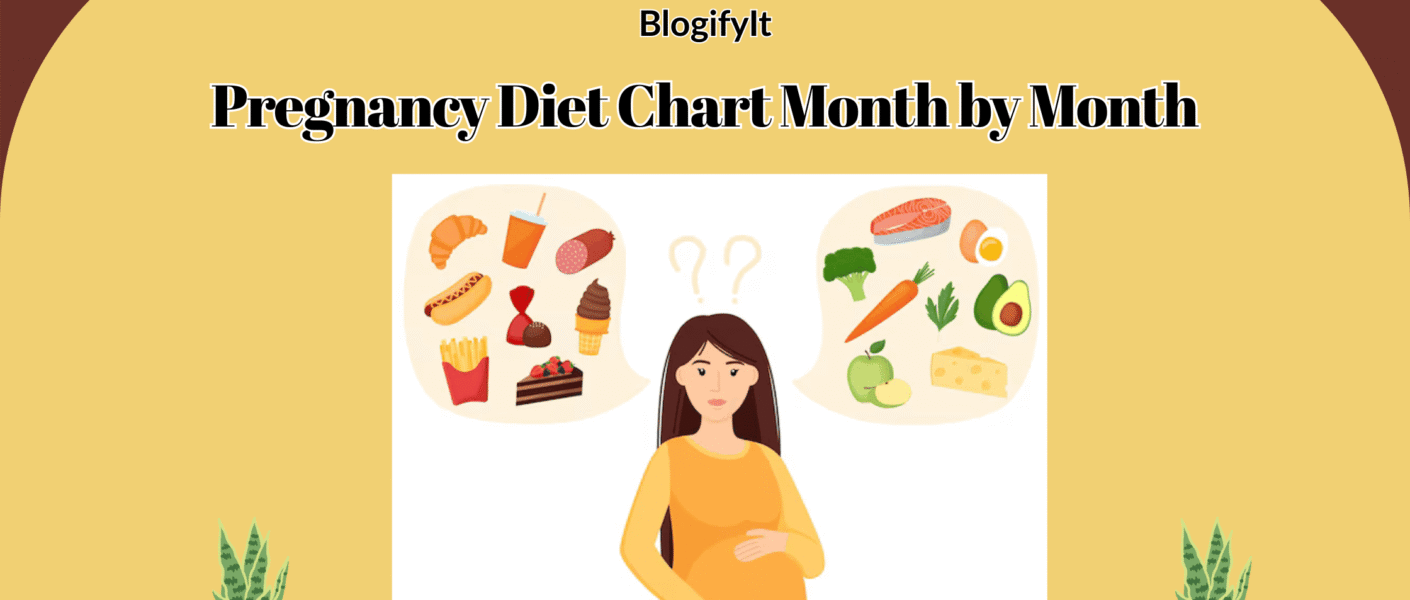Pregnancy is nothing short of a miracle. From the moment you conceive, your body begins working overtime—creating life, reshaping your organs, and fueling your baby’s growth, all in under 40 weeks. And what fuels all this change? Your diet.
While you don’t need to double your portions, you do need to double down on nutrition. The quality of what you eat matters more than ever—from folate to fiber, from calcium to choline. This month-by-month pregnancy diet chart is your go-to guide—backed by experts, structured with simple tables, and packed with practical tips to support both you and your growing baby.
Why a Diet for Pregnancy is Important-Especially Month by Month
Your nutritional needs don’t only increase during pregnancy; they also change. The first trimester is about brain and organ development. The second trimester is about growth and bone development. The third trimester is about preparing you and your baby for labor. Eating the right foods at the right time:
- Helps prevent the risk of birth defects
- Reduces risks for problems like anemia, constipation, or preterm labor. Regulates energy and levels of immunity.
- Supports normal fetal weight gain and brain growth.
- Prepares you physically for labor and postpartum recovery.
You don’t need to eat double—but you do need to eat smarter.
Also Read: How to Get Pregnant Naturally with PCOS: A Comprehensive Guide
Month 1 – The Foundation Stage
What Happens in this stage:
The beginning of pregnancy occurs from a cellular perspective; the fertilized egg goes down the fallopian tube and embeds into the uterine lining. At this point, the placenta begins to develop, and the neural tube – which becomes the brain and spinal cord, develops. This is a crucial time for the development of organs and cell proliferation. In the meantime, your body increases hormone production – mainly hCG and progesterone – which leads to fatigue, mood swings, and nausea.
Foods to Eat & Rationale:
- Folic acid-rich foods: spinach, lentils, oranges, beets – prevent neural tube defects.
- Vitamin B6: bananas, whole grains, potatoes – helps control morning sickness.
- Iron-rich foods: Red meat, beans, pumpkin seeds – help support the increasing amount of blood.
- Vitamin C: citrus fruits, tomatoes – helps in the absorption of iron.
- Hydrating options: coconut water and herbal teas – are good options to reduce bloating and fatigue.
Sample Diet Plan:
Here is a pregnancy diet plan for a healthy baby:
| Meal | Items |
| Morning | Warm Water + 4 soaked almonds |
| Breakfast | Oats + banana + chia seeds + boiled egg |
| Snack | Orange or pear |
| Lunch | Spinach dal + brown rice + cucumber salad |
| Snack | Ginger tea + toast with nut butter |
| Dinner | Grilled chicken or paneer + sweet potato + steamed broccoli |
Month 2 – Nausea and Early Development
What Happens in this Stage:
Your baby is developing into a tiny tadpole. Major organs develop, a heart starts beating, limb buds and then arms and legs begin to form, and facial elements begin to shape up. When compared with last month, pregnancy-related hormone levels fluctuate this month to their highest degree, which means nausea (often referred to as morning sickness), bloating, and pregnancy fatigue may get worse. You also may find you are more sensitive to taste and smell than ever before.
Foods to Eat & Why:
- Omega-3s: Salmon, flaxseeds, walnuts – supports brain and eye development.
- Vitamin E: Sunflower seeds, almonds – supports cell formation.
- Iron + vitamin C combinations: Lentils + citrus, spinach + lemon – increases absorption.
- Zinc: Pumpkin seeds, chickpeas – supports immune function and tissue repair.
- Soothing foods: Plain crackers, ginger, applesauce, etc – helps reduce nausea.
Sample Diet Plan:
Here is 1 to 3 months pregnancy diet chart:
| Meal | Items |
| Breakfast | Spinach-banana-yogurt-flax seed smoothie |
| Snack | Crackers + cheese or a handful of almonds |
| Lunch | Vegetable khichdi + ghee + curd |
| Snack | Lemon water + digestive biscuits |
| Dinner | Baked salmon or baked tofu + mashed potatoes + sautéed carrots |
Month 3 – Energy Returns
What Happens in this Stage:
Your baby is now considered a fetus, just about the size of a plum. The first trimester of pregnancy ends at the beginning of this month. Fingers, toes, ears, and eyelids are completely formed, and internal organs are already functioning. The placenta has developed and can produce hormones, often alleviating morning sickness. You may notice renewed energy, an increase in appetite, and the beginnings of a baby bump.
Foods to Eat & Why:
- Calcium-rich: Milk, tofu, fortified plant-based milk – for bone development.
- Vitamin D: Egg yolk, mushrooms, sunshine – help calcium absorption.
- High Fiber: Oatmeal, beans, pears – to support digestion.
- Probiotics: Yogurt, kefir – for gut health and immunity.
Sample Diet Plan:
| Meal | Items |
| Breakfast | Cereal with cow’s milk and strawberries |
| Snack | One boiled egg + an orange |
| Lunch | Chickpea salad + whole wheat roti |
| Snack | Yogurt with chia seeds |
| Dinner | Tofu stir-fry + quinoa + spinach soup |
Also Read: Why 1st Trimester is The Toughest: 5 Alarming Signs
Month 4 – Baby’s Growth Spurt
What Happens in this Stage:
Congratulations, you are now in your second trimester, usually the most pleasurable stage of pregnancy. Your baby’s bones are starting to harden, and some muscle tissue is forming, which allows movement. Facial features are becoming more defined, and the nervous system continues to mature. Your energy levels should be increasing, and your belly is rounder. You may even start to feel some light flutters (the early movements).
Also Read: Major Baby Growth During the 2nd Trimester of Pregnancy
Foods to Enjoy & Why:
- Protein: eggs, chicken, lentils – this is important for muscle and tissue development.
- Iron: spinach, dates, red meats – importance in preventing anemia as your blood volume increases.
- Choline: eggs, soybeans – required for the development of the brain and spinal cord.
- B-complex vitamins: whole grains, legumes – important for energy and maintaining a positive mood.
Sample Diet Plan:
| Meal | Items |
| Breakfast | Scrambled eggs with spinach + whole wheat toast |
| Snack | Mixed nuts + coconut water |
| Lunch | Chicken wrap + beetroot salad |
| Snack | Fruit shake or buttermilk |
| Dinner | Dal + brown rice + stir-fried okra |
Month 5 – Baby’s Bones & Kicks
What Happens in This Phase:
Your little one is growing rapidly, and bones are becoming more solid, muscles developed enough for you to begin to feel the first baby kicks, which is called “Quickening.” Hair, eyebrows and eyelashes are beginning to grow. Your uterus will grow, which may lead to some backaches or leg cramps. Blood flow is improving, which makes for a good time to start eating iron-rich foods!
Foods to Eat & Why:
- Calcium-rich foods: Yogurt, tahini, tofu – bone and teeth growth.
- Vitamin C: Oranges, bell peppers – they support the body’s collagen, especially for baby skin and blood vessels.
- Magnesium: Avocados, brown rice, whole grains – they help muscles relax and prevent cramps.
Sample Diet Plan:
| Meal | Items |
| Breakfast | Yogurt parfait with kiwi and granola |
| Snack | Orange + roasted sunflower seeds |
| Lunch | Rajma + multigrain roti + salad |
| Snack | Carrot sticks + hummus |
| Dinner | Stir-fried tofu or fish + quinoa + sautéed spinach |
Month 6 – Development of the Brain & Hearing
What Happens in this Phase:
Your baby is hitting a major milestone in terms of brain development, now the brain is beginning to control movement and sensory perception. The ears are completely developed now and the baby will be able to react to external sounds. The lungs will continue to develop, but they are not fully functional. Your body can develop back pain, indigestion, or leg cramps due to retaining fluid and the mass of the growing uterus.
Foods to Eat and Why:
- B vitamins: Whole grains, legumes – fuel for nervous system function.
- Potassium: Bananas, sweet potatoes – balance body fluids and minimize chances of cramping.
- Fiber: Beans, leafy greens, fruit – alleviate constipation and support gut health.
Sample Diet Plan:
| Meal | Items |
| Breakfast | Oatmeal + walnuts + banana |
| Snack | Steamed corn + lemon |
| Lunch | Vegetable pulao + curd + cucumber |
| Snack | Trail mix + buttermilk |
| Dinner | Grilled chicken + mashed potato + sautéed beans |
Month 7 – Energy and Digestive Support
What Happens in This Phase:
Your baby begins to gain fat quickly as they prepare for life outside the womb. Their organs are nearly developed and will begin to move in a practice of breathing motions. You may be feeling fatigue and some digestive distress (constipation, heartburn, bloating, etc.) as the uterus continues to push against your internal organs. You may also start to experience Braxton Hicks or practice contractions at this stage in your pregnancy.
Foods to Eat and Why:
- Complex carbohydrates: Oats, brown rice, sweet potato – help provide sustained energy.
- Iron and folate: Spinach, dates, lentils – prevent anemia.
- High-fiber foods: Apples, flaxseed, legumes – benefit digestion.
Sample Diet Plan:
| Meal | Items |
| Breakfast | Whole wheat pancakes with berries + honey |
| Snack | Toast with peanut butter |
| Lunch | Chickpea salad + roti |
| Snack | Banana + warm milk |
| Dinner | Moong dal + rice + steamed vegetables |
Month 8 – Brain Comparison & Sleep Support
What Happens in this Phase:
The baby’s brain is experiencing rapid growth as neural connections are formed to allow future learning and memory. Most of the body’s systems are well developed now (except for the lungs, which continue maturing). You may be feeling heavier and having trouble sleeping, which may be caused by many midnight trips to the bathroom, body aches, or the active movement of your baby. It’s important to stay hydrated and make sure to eat only light, nutritious foods this month.
What Foods Should I Eat & Why:
- Omega-3’s: Salmon, flaxseed oil, walnuts – to support brain development.
- Melatonin promoting foods: Tart cherries, oats – to help regulate sleep.
- Hydrating options: Cucumber, watermelon, coconut water – to help with swelling and support kidney function.
Sample Diet Plan:
| Meal | Items |
| Breakfast | Whole wheat pancakes with berries + honey |
| Snack | Toast with peanut butter |
| Lunch | Chickpea salad + roti |
| Snack | Banana + warm milk |
| Dinner | Moong dal + rice + steamed vegetables |
Month 9 – Labor Prep & Final Nourishment
What Happens in This Phase:
Your baby is now totally developed and ready for birth. The head may go down into the pelvis (lightening), relieving pressure on the lungs though creating pressure on the bladder. The cervix begins to soften to prepare for labor. You may experience strong Braxton Hicks contractions, nesting, and a strong combination of fatigue, and readiness. Make sure to focus on easy-to-digest and energy-boosting foods to the greatest extent possible to support labor and preparation.
Foods to Eat and Why:
- Easily Digestible Protein: Eggs, lentils, tofu help support stamina and strength.
- Slow-Releasing Carbs: Rice, oats, bananas supply energy during labor.
- Hydrating Foods: Watermelon, coconut water assist to maintain fluid levels and reduce swelling.
- Natural laxatives: Dates, figs, which potentially support a better labor.
Example Diet:
| Meal | Items |
| Breakfast | Oatmeal with banana and chia seeds |
| Snack | Dates + coconut water |
| Lunch | Chicken or tofu wrap + salad |
| Snack | Seasonal fruits (exclude papaya) |
| Dinner | Dal soup + rice + steamed vegetables |
Common Daily Diet Chart of Pregnant Lady (All Trimesters)
| Time | What to Eat |
| Morning | Warm lemon water + 4 soaked almonds |
| Breakfast | Oats, smoothie, or multigrain toast + protein |
| Snack | Fruit or boiled egg |
| Lunch | Whole grain + protein + vegetables + salad |
| Snack | Nuts or buttermilk |
| Dinner | Light soup or rice bowl + cooked veggies |
| Before Bed | Warm milk or banana |
Foods to Avoid During Pregnancy and Why
There are some foods to completely avoid at all times in pregnancy; not just for your own health, but for the health of your baby’s development.
- Raw or undercooked meats and eggs may contain harmful bacteria (like Salmonella or Listeria) which can cause food poisoning and possibly loss of a pregnancy.
- Fish containing high levels of mercury (like shark, swordfish, king mackerel, or tilefish) can harm your baby’s developing nervous system. Eat low mercury fish like salmon or sardines instead.
- Raw fish, which is in sushi that contains raw seafood, can have parasites and bacteria that your body is less able to handle while pregnant.
- Unpasteurized dairy products (like raw milk, some soft cheeses and raw cream) can contain Listeria bacteria that can cause stillbirth or serious infection.
- Deli meats and hot dogs should be avoided unless they are heated completely through. Like other cold products, they can have Listeria bacteria.
- Alcohol should be avoided completely – even in small amounts – alcohol can disrupt fetal development and cause symptoms of Fetal Alcohol Syndrome.
- Excess caffeine consumption (over 200 mg/day) may increase risk of miscarriage and low birth rate. Having coffee is fine in small amounts and it is best to never drink energy drinks. And please don’t drink multiple cups!
- Raw dough or flour may look innocent, but we know E. coli can be in it, so do not lick the spoon when you are baking.
Also Read: Things You Should Do During the 3rd Trimester of Pregnancy
Final Thoughts
Pregnancy is one of the most powerful transitions your body can go through—and the right nutrition can be your greatest ally in that journey. When following this month-to-month nutrition guide, you will not only feed your growing baby but you will also nourish your own body and mind. It is not about being perfect-it is about making educated and loving choices at every meal.




